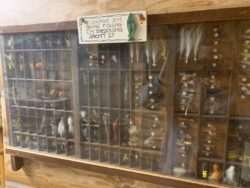Most fly fishermen get their fly boxes out and begin an inventory. In their boxes they discover worn out flies, broken hook flies, flies with knotted tippet attached, and old flies that used to be money but are now stinkers.
It is funny how some flies work so great and then they don’t. These flies often become fly throw aways. Many of us pass these old flies along to new fishermen or kids. To them a fly is a fly. Many of our first flies tied also look ratty and worthless. They often go down the river too.
Hold onto a library of your old flies. You may discover that they work again. You can always give them new life. I keep mine in an antique, type set, drawer. I glued corks into the chambers and placed the veterans in place. A piece of glass protects them. It is hanging on my wall. 
I also have a bin of flies to recycle. Just because the fly is chewed up does not mean the hooks are shot. I strip off the old fly material and resharpen the hooks. These can then go back into the hook inventory. Other repairable flies can be fixed for a future opportunity.
Flies are an investment in time and money. Whether you buy your flies or tie your own, being thrifty is a good thing.
Fishermen lose boatloads of flies each season. Look for flies in bushes and snags. Also clean up any trash left behind by les thoughtful anglers. Strike indicators, wrappers, plastic containers, and odd and ends need to be properly disposed of. I carry a pair of pruners to cut any branch that grabs my fly. There are often other flies in the same place.
When I visit various fishing access sites, I use a magnetic, wheeled, workshop nail cleanup tool to search for abandoned and lost hooks. Some flies are too far gone but I often find dozens of fixable flies. At the very least, I get an idea about what most fishermen are using. At the Raynold’s Pass access on the Madison River, I find dozens of Zebra Midges. Other old flies, fishing line, and trash, are removed from the area.
An average fly fisherman loses, or wears out, 10-12 flies a day. At $2.50 a fly, that’s over $25. They also tend to use up around 3 yards of tippet material each outing. This line is used up as knots are tied, snags are removed, leaders are changed, droppers are added, etc. If this tippet is Fluorocarbon, the line will take hundreds of years to degrade. Other larger pieces of line and leader can entangle birds and critters. Flies lost in a fish will rust in just a few days. Flies caught on branches and grasses take longer. Flies lost in branches, grasses or parking lots take 4 months to degrade. Insects and other critters may mistake flies for real food and eat them. I have also removed several flies from the stocking feet of anglers getting their boots on at the access.
One reason so many flies are lost, is that anglers tie crappy knots. Learning how to tie a leader knot, dropper, or a basic clinch knot requires some instruction and practice. Many fishermen also wear their tippet, or store their rods/reels in the hot, bright sun where the line weakens.
Angling means tangling. Like it or not, we will always lose our flies. I watched an experienced fly guy open his fly box on a windy day and saw several dozen new ties blow away. A small magnet glued into the bottom of the fly box compartments would have held his flies in the box. Using the buttons or Velcro on your vests will keep the fly boxes in place. Using a fly fleece patch on your vest works best if it has a cover flap to keep the flies from falling off.
Even the best fly guys have bad days when every snag or branch, wants to take your flies. Learn from mistakes and protect your fly investments.
Fly smarter!
Montana Grant 